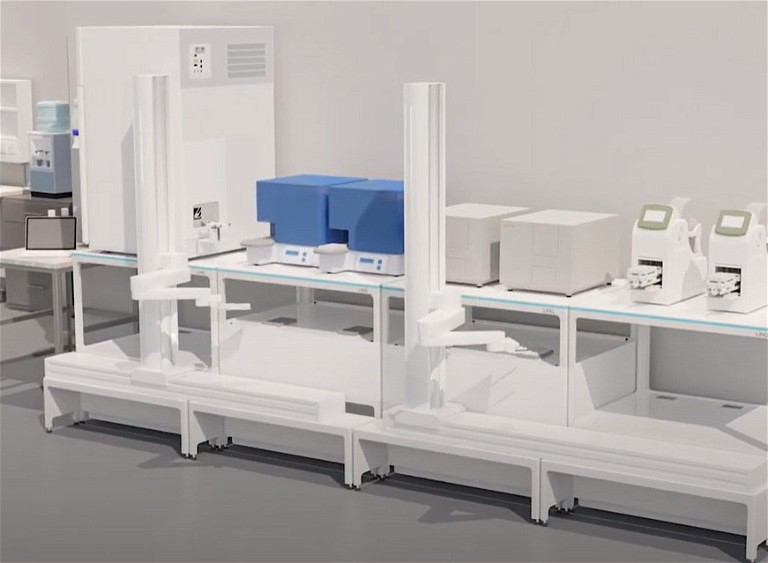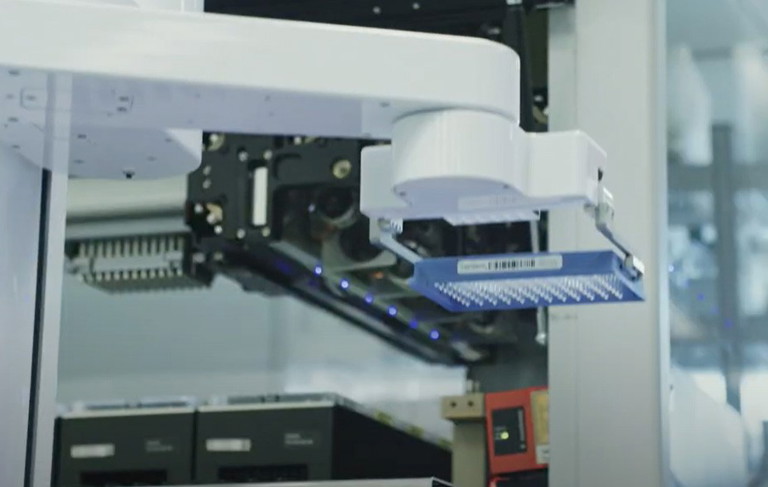Lab automation: streamlining processes
The journey to full automation – for labs of all sizes
With the lab of the future becoming increasingly automated, how will this change workflows and how can the industry prepare for this?
Russell Green at Automata Technologies
The laboratory of the future will be automated – there’s no question about that.
Whether focused on research and development (R&D), bioprocessing, testing, analytics or research, our best scientists will be empowered to focus their full creative and analytical capabilities on solving some of the biggest challenges in life sciences.
However, currently too many talented minds are occupied by menial, manual, mind-numbing tasks.
Scientists with advanced degrees are performing the same repetitive actions – moving microplates, scanning barcodes, pipetting by hand – thousands of times, hour after hour. Burnout is rife and the industry faces a staffing crisis.
Automating individual processes often leaves staff no better off – for example, manual pipetting has been replaced by the equally mundane task of moving plates from one bespoke, inflexible machine to another.
Even labs that use some automation could be missing the vast untapped potential of truly integrated workflow automation.
But how can labs start to take those steps towards full automation? It can seem a daunting process and it is often difficult to know where to start, and where to invest to get the best productivity returns – particularly for smaller organisations with limited budgets.
What is lab automation?
Laboratory automation is the integration of automated technologies into the laboratory to enable new and improved processes.
Typically, automation solutions have eliminated the most repetitive tasks in a lab that have previously been performed manually by technicians or scientists. However, with current technology, more and more complex processes and even whole workflows, can be automated. Automated technology is increasingly becoming a requirement for today’s laboratories to remain competitive, meet demand and expedite innovation.
The benefits of lab automation
Today’s busy laboratories face increasing pressures to improve throughput, efficiency and quality, while their resources and manpower are often stretched to the absolute limit. Managing important activities like sample preparation, cell line development or precise genomic workflows presents significant challenges to labs of all shapes, sizes and specialities. For many labs, automation can be a game changer – replacing manual, repetitive tasks, improving quality and traceability of results and increasing operating hours without requiring additional staff. Proven benefits include improved reproducibility through reduced handler-induced variability and contamination, resulting in improvements in the quality of results; better data accuracy from consistent techniques; greater traceability with accurate documentation and chain of custody of data capabilities; efficiency, with time saved on repetitive tasks being spent on research, planning or running other protocols, even 24 hours a day; improved safety by reducing staff exposure to hazardous substances as well as reducing the risk of contamination; and faster translation from bench to bedside as the technological leap from laboratory to commercialisation can be shorter if aspects of the process have already been mechanised.
Approaching the daunting task of automation
For the best results, the automation journey should start with an organisation’s commitment to learning and self-reflection, looking beyond individual devices and seeing the bigger picture of a lab’s true needs and potential.
By digitally and robotically connecting modular instruments into a cohesive, parallelised workflow, whole assays – and even entire labs – can be automated. These joined-up systems can process, test and store specimens autonomously, allowing fully remote operation by lab staff whose skills can be devoted to real science.
The result: lab performance is supercharged. Productivity of both high-value equipment and people is increased. Repetitive strain injuries are limited; contamination risk is reduced; and human error is eliminated.
Lessons from the manufacturing industry
Open, integrated automation at an enterprise level is far from new. On factory floors around the world, humans and robots are working side by side every day. In these highly automated spaces, the experience of technicians and engineers is used purposefully for complex tasks, leaving high-output applications to automated systems.
However, rather than building the same product for years on end, biopharma labs are about discovery and change. This is why many in the life sciences industry have hesitated to borrow such rigid production techniques. However, a new approach is possible that combines the repeatability, scale, quality, throughput and efficiency enjoyed by factories but with the flexibility and adaptability demanded by cuttingedge labs.
Lesson 1: Optimising bottlenecks
It’s critical to get maximum utilisation out of your most expensive equipment. The closer you can get to 100% utilisation of these pieces of equipment, the more efficient your lab will be. However, these instruments are often left unused while they wait for the completion of lengthy manual processes such as sample preparation. By investing in the efficiency of these processes at the start of a workflow, labs can reduce waiting and get more value from their flagship devices.
Lesson 2: Parallelising processes
On a factory floor, manufacturing steps are decoupled so that processes run independently; no step relies on the completion of another, maximising efficiency.
Labs sometimes fail to reap the same rewards as devices often have multiple functions that work in a linear manner – this often creates an unintended bottleneck as staff wait for an uninterruptible process to finish before moving on to the next step. Identifying and breaking down SOPs into units of operations – decoupling steps such as pipetting or thermocycling – is key to helping these to all be parallelised on different pieces of equipment.
Lesson 3: Harnessing robotic and digital connections
In an automotive factory, equipment connects all the stages on the assembly line so that the car autonomously moves through different instruments for processes such as attaching parts or spray painting. Yet in a lab, humans still provide these connections. By adding robotic connections between lab instruments, vials and plates can be physically moved from one instrument to the next without human intervention. When linked with advanced software, the instruments exchange data and work harmoniously, overcoming blockers dynamically and communicating with operators remotely for added confidence. In an open, integrated system, the hardware and software layers come together to orchestrate entire workflows and reduce manual processes significantly. The result: a massive increase in output.
So where do you start?
The three stages to becoming a smart lab
1. Adopting a singular instrument
Choose a single automated instrument to target a specific inefficient task. The best place to start is by automating the dull, strenuous and repetitive jobs. You’ll take the pressure off staff who’d otherwise be expected to stand over their experiments for hours and hours every day and give them more walkaway time to focus on the work that uses their expertise and skill set. Some lab processes ripe for automation include sample logistics, cell maintenance, QA testing and repetitive assays.
2. Expanding automation capabilities
Create an automated workflow by linking multiple automation technologies. Take the automated liquid handler, for example. Liquid handling is just one step towards eliminating repetitive, mundane and manual processes in the lab. However, automating single processes like this doesn’t meaningfully increase walkaway time, activity levels and results or improve accuracy if the rest of the sample preparation stages – such as loading, capping and uncapping, bar code scanning, weighing and transferring – are still performed manually. Automating every task in a workflow would make the process faster, more precise and less prone to human error and enable the workflow to continue while the scientist does something else.
3. Evolving into a fully digital lab
Combine a collection of modular instruments and processes to become a multifunctional digital lab. With start-ups and scale-ups innovating at an ever-increasing rate, automation will have to adapt to high-growth situations where scientists are moving away from traditional, fixed systems. Thinking modular enables lab design to be adaptable and scalable so that growth companies can reconfigure their workflow and scale to meet changing requirements. That means labs are working with a hyper-adaptable system that can dynamically manage changes in workflows and throughput demands.

Making the most of automation in your lab
Integrating automation holistically into your lab can make day-to-day work much more satisfying, allowing staff to focus on analysing results and planning the next experiment, while avoiding the strain and burnout associated with repetitive tasks. So, how do you automate in a way that allows your scientists to focus on solving science’s biggest problems, and not babysitting million-dollar machines?
1. Choose a capability-based approach
Traditional workflow automation systems can be large, rigid structures that don’t give labs the flexibility to innovate or change. Instead, a ‘capability approach’ means opting for modular solutions that combine robotic and digital connectivity for ultimate flexibility. Modular solutions can start small, saving you lab space – an expensive and sometimes scarce commodity in biopharma – and be expanded when the need arises. With this level of flexibility, instruments can also be accessed for non-automated processes, and are easily replaced or new equipment integrated, meaning experimentation isn’t restricted as it can be with non-modular fixed automation solutions.
2. Establish connections that stretch from end to end
Interconnected automated systems are greater than the sum of their parts. By thinking about automation holistically, you can leverage the full potential of your existing equipment and build more meaningful and scalable automation into your lab. It’s no doubt a daunting task.
In labs, automation platforms are connecting instruments that have vastly different communications protocols. But with advances in automation technology, management of these can become simple and seamless.
3. Look at data on a larger scale
Make sure to choose a platform that brings together various sources of information to offer you a big picture perspective on how your lab is performing. With a fully automated system, you’ll receive anywhere between five to ten times the amount of data than you would traditionally access.
Not only can labs receive results from experiments faster and more accurately, but they can also access all the data pertaining to how that result was gathered, such as the sample, the experimental processes, the environment and equipment data. This data accessibility is a vital component of FAIR data and ultimately facilitates the adoption of AI/machine learning technology when your lab is ready.

4. Accommodate the need for pace and scale
Many labs need to execute workflows at speed. Whether it’s faster testing, increased sample throughput or the identification of more cells or targets, the increased speed demanded by mass production pushes up the risk of human error and contamination, especially when scale implies greater numbers.
Automation efficiencies can be a powerful tool to give companies a competitive edge while also ultimately benefiting patients and even the environment, through its ability to reduce wastage.
With cloud software, technicians can digitally link and orchestrate the commands and data flow between digital and physical resources, so workflows can be built, executed and monitored from anywhere. Some automation software also allows remote-based troubleshooting of errors that may occur during workflows allowing assays to complete more reliably, and run for longer – even when you’re away from the lab.
The lab of the future
Open, integrated automation is needed today for laboratories to future-proof themselves, remain competitive and meet demand and we will see more and more labs where humans and robots are working side-by-side. We may even start to see ‘dark’ labs – operating basic processes 24 hours a day, without human interaction, maximising efficiency and shortening schedules for faster delivery of results.
The lab of the future will not only allow scientists to work smarter by running more processes with greater adaptability, higher quality data, improved KPIs and reduced costs. It will also help to drive life sciences innovation forward and make those long-term, big-picture goals more achievable for medicine – bringing life-saving treatments to market faster or changing how labs can test for and diagnose disease.

Russell Green is director of Product Applications at Automata Technologies. After graduating from University of Leeds, UK, with both a BSc and a PhD in Biochemistry and Molecular Biology he went on to forge a career covering automation sales, marketing, development and implementation with companies such as Beckman Coulter Life Sciences and Synthace. Utilising his scientific background and automation expertise, Russell leads the market strategy for Automata’s lab automation platform, LINQ.